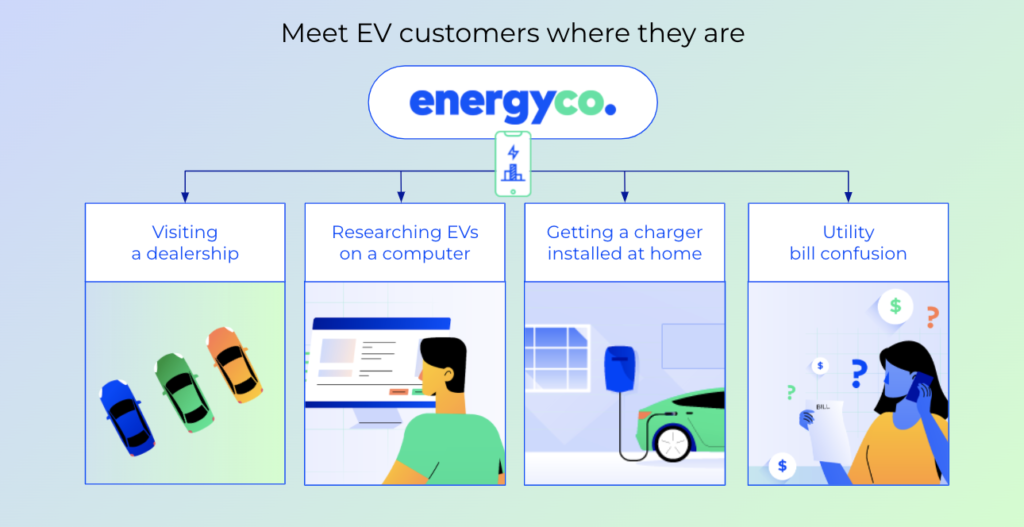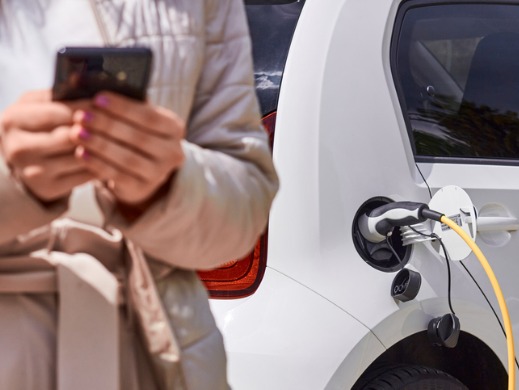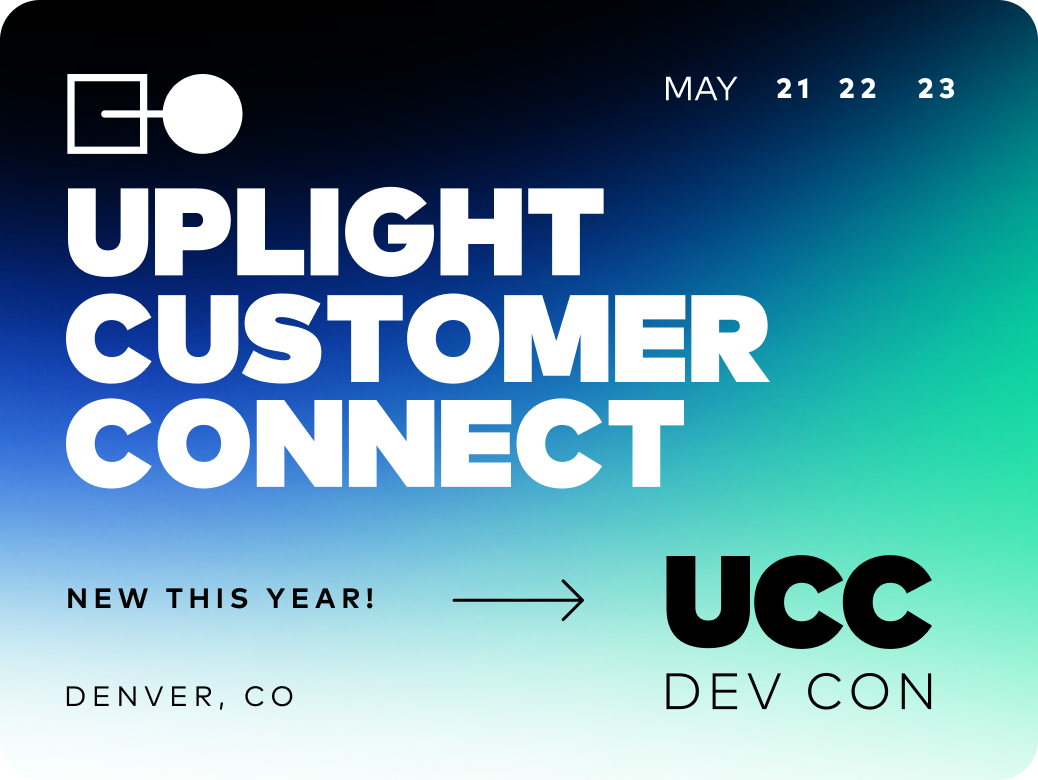Every customer touchpoint is crucial to education and enrollment.
This article is part of a series; Read Principle 2: Cast a Wide Net to Identify EV Drivers, and EV Residential Charging Principle 3: Maximize EV Data Aggregation , and EV Residential Charging Principle 4: Make Managed Charging Simple.
As the number of EVs on the road grows, energy providers have to provide the charging infrastructure to power them. Yet, this is uncharted territory, and many utilities don’t know where to get started, especially when serving residential EV owners. This is the first of a four part series of the key principles of residential charging.

A recent study found that 78% of U.S. adults surveyed said they had no access to EV charging where they currently park their vehicles. Had this study from Morning Consult asked whether there was a regular electrical outlet in their garage or parking space (which is the only requirement for charging at home), results would have looked very different. Lisa Whalen, the author of the survey, explained that she did this on purpose, “It just shows the disconnect in the education of the public” about charging. At Uplight, we believe introducing utility information earlier in the EV buying journey can close the educational disconnect and set consumers up for long term success.
We do have an electric vehicle supply equipment (EVSE) gap today that federal and state funding is working to close. But an equivalent gap is still in consumer education. By 2030, 80% of charging infrastructure will be residential and 40% of energy demand from all EVSE deployed will be home charging, according to Navigant. This is a crucial time for collaboration between auto-makers, charging manufacturers, and utilities to provide educational tools so that more customers can not only feel confident about charging at home, but also understand best practices for at-home charging.
Uplight partnered with See Change Institute to do more in-depth customer research to understand the current gaps in customer education. We found that prior to an EV purchase, participants typically focused on the basic concept of ensuring that they can charge. During the pre-purchase phase, there are two key participant patterns: (1) the reactive customer, who doesn’t do research before purchasing, and (2) the in-depth customer, buyers that investigate everything related to their new vehicle ahead of purchasing it. As mass-adoption of electric vehicles grows, let’s assume the percent of reactive consumers will also increase.
Once those reactive customers get their EV home, they may do more in-depth charging-related research, but this is typically triggered by a charging issue or challenge they encounter. Right now many customers turn to their auto OEM or dealership when they are frustrated with their charging experience.
So how do we get ahead of this and make sure the first time customers reach out to their utility isn’t an angry phone call about their increased bill? By bringing the utility further up in the EV buying journey, Uplight believes that all stakeholders will benefit, including customers, utilities, infrastructure planners and EV program managers, and auto manufacturers and car dealerships :
- Customers will ultimately save money through utilities’ EV programs.
- Utilities will be able to drive more customers onto EV programs that are critical to their long term goal of balancing increased energy demand from electric vehicles and reaching decarbonization goals.
- Infrastructure planners and EV Program Managers will gain more visibility and insight on EV location as well as charging behavior.
- Auto manufacturers and car dealerships will have less pressure to become residential charging experts and educate consumers––leading to higher customer satisfaction post-purchase and longer customer lifetime value.
Uplight is teaming up with a growing list of consumer-facing EV companies (auto-makers, EVSE suppliers, installers, etc.) to expand the utilities’ customer reach–maximizing opportunities for education and enrollment earlier in the customer journey. Here are four ways utilities can leverage Uplight’s capabilities to reach more EV drivers:
1. Leverage the brand power of Auto Manufacturers & EVSE Suppliers
Customers are regularly interacting with the car they drive and the hardware in their garage. Uplight can help utilities leverage that brand power through enrollment integrations built into consumer facing brands such as Enel X. For example, email campaigns and web portal integrations with the market’s leaders in Level 2 Chargers can educate customers on utilities’ EV rates and managed charging programs, leading to higher enrollment rates.
2. EVSE sales though utility-branded Marketplaces
Uplight’s Marketplace provides a white-label ecommerce site for utilities to sell energy efficiency products through their own brand. Through educational marketing campaigns, utilities can teach customers about the benefits of Level 2 Chargers. Sixteen utilities already use Uplight’s Marketplace to sell residential EVSE. These utilities saw almost a 10X increase in EVSE sales from 2020 to 2021. When paired with an instant rebate at point-of-purchase, utilities sell 3.5X more chargers. Uplight’s unique EV Pre-Enrollment capabilities allow customers to opt-in to utility programs at check-out driving an astounding 76% enrollment rate!
3. Partner with Electrician Networks
Uplight has teamed up with Qmerit, national network of electricians that provides in-home Level 2 charger installations. Our digital-first installation scheduling process is integrated with charger purchases on the Marketplace. This seamless installation process also allows utilities to leverage the in-person touch point as an opportunity to educate and enroll customers onto utility EV rates and managed charging programs.
4. Enable programs through telematics (data directly from electric vehicles)
Upgrading to a Level 2 Charger can be viewed as burdensome, and most participants in the See Change Institute study did not upgrade to a Level 2 charger. For those that did, the key consideration was charging speed. This should not be a barrier for educating customers on the benefits of charging off-peak or participating in managed charging. Uplight provides a way for utilities to offer customers a way to connect their vehicle directly to EV programs offered through the utility. Supporting both EVSE and vehicle telematics provides more choices and optionality to participate in money saving and grid optimizing programs.
The majority of consumers are unaware of utility programs such as EV-specific rates or managed charging. Yet consumers also trust their utilities for information and want more EV- and charging-specific communications from them—information that is simple and available close to the time of their EV purchase. There won’t be a one-size fits all solution to getting customers the information they need, but through smart integrations and collaboration with other EV consumer-facing channels we can bridge this educational gap and electrify transportation for the masses.





